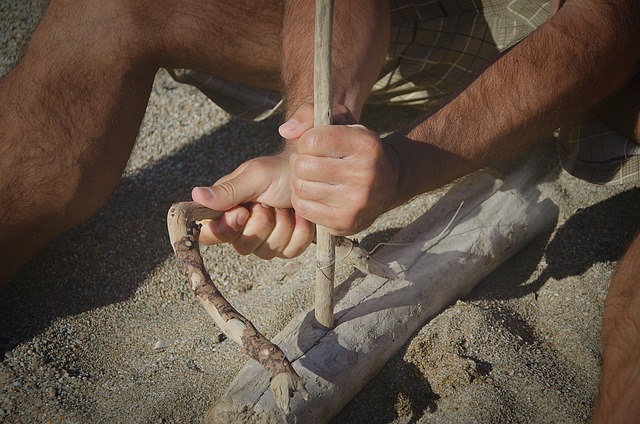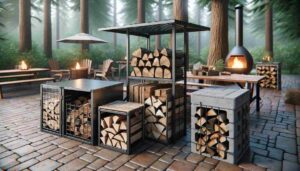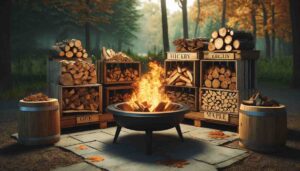When it comes to outdoor adventures, camping, or even cozy evenings by the fireplace, having a reliable fire starter is essential. While you can certainly purchase commercial fire starters, there’s something uniquely satisfying about crafting your own. Plus, homemade fire starters can be cost-effective and eco-friendly. In this comprehensive guide, we’ll explore a wide range of DIY fire starters that cater to various preferences and needs. Whether you’re a seasoned outdoors enthusiast or just looking to make your fires at home a bit more special, you’ll find something here for you.
Why Homemade Fire Starters?
Before we dive into the world of DIY fire starters, let’s understand why they’re worth exploring in the first place. Homemade fire starters offer a multitude of benefits:
Cost-Effective
Commercial fire starters can be pricey, especially if you use them frequently. Crafting your own can save you money in the long run, as many of the materials needed are readily available at home or can be obtained inexpensively.
Eco-Friendly
Using homemade fire starters allows you to repurpose common household items that might otherwise end up in the trash. This eco-friendly approach reduces waste and minimizes your environmental footprint.
Customizable
When you create your own fire starters, you have full control over their appearance, scent, and performance. You can tailor them to suit your specific needs and preferences, making each fire-starting experience unique.
Fun and Creative
Making DIY fire starters can be a fun and creative activity for individuals and families alike. It’s an excellent way to get children involved in outdoor activities and teach them valuable skills.
Now that you’re aware of the advantages, let’s explore some fantastic DIY fire starters you can easily make at home.
DIY Fire Starters with Household Items
Cotton Ball Fire Starters
Cotton balls are versatile and readily available. To create cotton ball fire starters, you’ll need:
- Cotton balls
- Wax (paraffin or old candles)
- Double boiler or microwave-safe container
- Melt the wax in a double boiler or microwave-safe container.
- Dip the cotton balls into the melted wax, coating them thoroughly.
- Allow the wax-coated cotton balls to cool and harden.
- Store them in a cool, dry place until you’re ready to use them.
These small, wax-coated fire starters are incredibly effective and easy to ignite, making them perfect for camping trips and starting fires at home.
Dryer Lint Fire Starters
Dryer lint is another common household item that can be repurposed into fire starters. To make dryer lint fire starters, gather:
- Dryer lint
- Empty toilet paper rolls or paper towel rolls
- Wax (paraffin or old candles)
- Stuff dryer lint into the empty cardboard rolls.
- Melt the wax and pour it over the lint-filled rolls, ensuring the lint is saturated.
- Allow the wax to cool and harden.
- Cut the rolls into smaller sections to create individual fire starters.
These compact and lightweight fire starters are ideal for backpacking trips and emergency situations.
Egg Carton Fire Starters
Egg cartons can be transformed into convenient fire starters. For this project, collect:
- Empty cardboard egg cartons
- Dryer lint or shredded paper
- Wax (paraffin or old candles)
- Fill each compartment of the egg carton with dryer lint or shredded paper.
- Melt the wax and pour it over the lint or paper, ensuring it’s well-soaked.
- Allow the wax to cool and solidify.
- Cut or tear apart the individual compartments to create separate fire starters.
Egg carton fire starters are not only effective but also easy to store and transport. They are perfect for campfires and fireplaces.
Pinecone Fire Starters
If you’re looking to add a rustic touch to your fires, pinecone fire starters are an excellent choice. Here’s what you’ll need:
- Pinecones
- Wax (paraffin or old candles)
- String or twine
- Tie a length of string or twine around each pinecone, leaving a long tail for easy handling.
- Melt the wax in a double boiler or microwave-safe container.
- Dip the pinecones into the melted wax, ensuring they are fully coated.
- Allow the wax to cool and harden, then trim the excess string.
Pinecone fire starters not only ignite easily but also release a pleasant woodsy scent as they burn.
Wax-Based Fire Starters
Wax-based fire starters are popular due to their reliability and ease of use. Here are some variations you can create:
Wax and Sawdust Fire Starters
Sawdust is an excellent material for fire starters, and when combined with wax, it becomes highly effective. To make wax and sawdust fire starters, you’ll need:
- Sawdust
- Wax (paraffin or old candles)
- Muffin tin or silicone mold
- Mix the sawdust and melted wax in a ratio that ensures the sawdust is thoroughly coated.
- Spoon the mixture into muffin tins or silicone molds, compressing it firmly.
- Allow the wax to cool and harden, then remove the fire starters from the molds.
These compact fire starters are perfect for backpacking, camping, or keeping in your emergency preparedness kit.
Wax and Cardboard Fire Starters
Cardboard can also be repurposed into effective fire starters when combined with wax. Gather the following materials:
- Cardboard (old cereal boxes or packaging)
- Wax (paraffin or old candles)
- Knife or scissors
- Cut the cardboard into small, thin strips or squares.
- Melt the wax in a double boiler or microwave-safe container.
- Dip the cardboard pieces into the melted wax, ensuring they are fully saturated.
- Allow the wax to cool and harden.
These DIY fire starters are quick to ignite and provide a steady flame, making them suitable for starting larger fires.
Scented Wax Fire Starters
If you’d like to add a pleasant aroma to your fires, consider making scented wax fire starters. Here’s what you’ll need:
- Wax (paraffin or old candles)
- Essential oils (e.g., lavender, pine, or citrus)
- Molds or silicone ice cube trays
- Melt the wax in a double boiler or microwave-safe container.
- Add a few drops of your preferred essential oil to the melted wax and stir well.
- Pour the scented wax into molds or silicone ice cube trays.
- Allow the wax to cool and harden, then remove the scented fire starters.
These fire starters not only serve a practical purpose but also enhance the ambiance of your outdoor gatherings or indoor fires.
Wood-Based Fire Starters
Wood-based fire starters are excellent for kindling larger fires. Here are a couple of options to consider:
Sawdust Fire Starters
Sawdust is a readily available material that can be used to create highly effective fire starters. To make sawdust fire starters, you’ll need:
- Sawdust
- Wax (paraffin or old candles)
- Cardboard or paper egg cartons
- Mix the sawdust with melted wax to form a thick, consistent paste.
- Fill each compartment of the cardboard or paper egg carton with the sawdust and wax mixture.
- Allow the wax to cool and harden.
- Cut or tear apart the individual compartments to create separate fire starters.
Sawdust fire starters provide a sustained flame, making them ideal for lighting wood stoves, fireplaces, and campfires.
Wood Shavings Fire Starters
Wood shavings are another excellent choice for DIY fire starters. Gather the following materials:
- Wood shavings or wood curls (from untreated wood)
- Wax (paraffin or old candles)
- Muffin tin or silicone mold
- Mix the wood shavings with melted wax, ensuring the shavings are thoroughly coated.
- Spoon the mixture into muffin tins or silicone molds, compressing it firmly.
- Allow the wax to cool and harden, then remove the fire starters from the molds.
Wood shavings fire starters are perfect for those who enjoy the natural scent of burning wood. They are also highly effective in igniting fires quickly.
Charcoal Chimney
A charcoal chimney is a handy tool for quickly and efficiently lighting charcoal for grilling or starting a campfire. While you can purchase charcoal chimneys, here’s how to make your own:
Homemade Charcoal Chimney
To create a homemade charcoal chimney, you’ll need:
- Large metal can (such as a coffee can or paint can)
- Drill with a metal drill bit
- Wire coat hanger or metal handle
- Charcoal briquettes
- Use the drill to create several evenly spaced holes in the bottom of the metal can. These holes will allow air to flow and ignite the charcoal.
- Cut a length of wire coat hanger and bend it to create a handle for the can.
- Fill the can with charcoal briquettes.
- Place crumpled newspaper or a paraffin wax fire starter underneath the can.
- Light the newspaper or fire starter, and the chimney effect will quickly ignite the charcoal.
Homemade charcoal chimneys provide a convenient and cost-effective way to start charcoal fires for grilling or outdoor cooking.
Survival Fire Starters
In survival situations, having reliable fire starters can be a matter of safety and survival. Here are two DIY options for creating survival fire starters:
Char Cloth Fire Starters
Char cloth is a traditional fire-starting material that can easily be made at home. To create char cloth fire starters, you’ll need:
- 100% cotton fabric (old t-shirts or denim work well)
- Tin with a lid
- Fire source (such as a campfire or stovetop burner)
- Cut the cotton fabric into small squares or strips.
- Place the fabric pieces inside the tin and close the lid, leaving a small gap for smoke to escape.
- Heat the closed tin over a campfire or stovetop burner until it begins to smoke.
- Once the smoking stops, remove the tin from the heat source and allow it to cool completely.
- The char cloth is now ready to use. It catches sparks easily and can ignite other tinder.
Char cloth is an essential addition to any survival kit, as it can help you start a fire even in challenging conditions.
Fire Piston Fire Starters
A fire piston is a fascinating and effective fire-starting device that uses the principle of rapid air compression to ignite tinder. To make a fire piston, you’ll need:
- Small cylindrical tube (such as a thick plastic pen or aluminum rod)
- Rubber gasket or O-ring
- Wooden dowel or piston
- Char cloth or other tinder
- Drill a small hole through the center of one end of the cylindrical tube.
- Attach the rubber gasket or O-ring around the other end of the tube, creating an airtight seal.
- Insert the wooden dowel or piston into the open end of the tube.
- Load a small piece of char cloth or tinder into the hole at the sealed end of the tube.
- Rapidly push the piston into the tube with force. The compression of air inside the tube will cause the tinder to ignite.
Fire piston fire starters are a reliable and intriguing tool for wilderness survival enthusiasts.
Fire Starter Kits
If you’re looking for a comprehensive fire-starting solution, consider putting together a DIY fire starter kit. Here’s how to create your own:
DIY Fire Starter Kits
To assemble a DIY fire starter kit, you’ll need:
- Container (such as a metal tin or waterproof bag)
- Assorted fire starters (choose from the options discussed in this article)
- Waterproof matches or a fire striker
- Fire starter instructions (printed or written on waterproof paper)
- Select a suitable container for your kit. A metal tin with a lid or a waterproof bag works well.
- Fill the container with a variety of fire starters, including some that are wax-based, wood-based, and suitable for different weather conditions.
- Include a small box of waterproof matches or a fire striker.
- Add instructions on how to use the fire starters in case you or someone else needs to start a fire in an emergency.
Having a well-prepared fire starter kit on hand is a smart and practical choice for outdoor adventures or emergency preparedness.
Conclusion
In conclusion, DIY homemade fire starters offer a cost-effective, eco-friendly, and customizable way to ignite fires for camping, grilling, or cozy evenings by the fireplace. Whether you prefer cotton ball fire starters for their simplicity, wax-based fire starters for their reliability, wood-based fire starters for kindling larger fires, or survival fire starters for emergency situations, there’s a DIY option that suits your needs.
Experiment with different materials, scents, and shapes to create fire starters that not only serve a practical purpose but also enhance your outdoor experiences. Remember to store your homemade fire starters in a cool, dry place to ensure they remain effective when you need them most.
So, why not embark on a creative fire-starting journey and discover the satisfaction of crafting your very own homemade fire starters? Whether you’re a seasoned outdoors enthusiast or a novice camper, you’ll appreciate the convenience and charm of these DIY creations.










